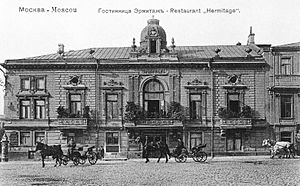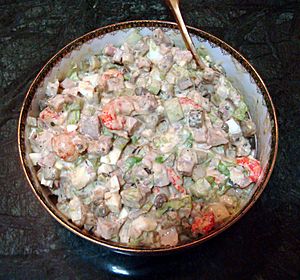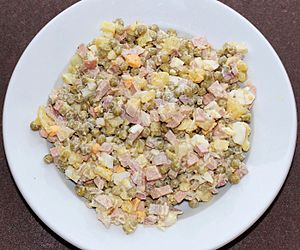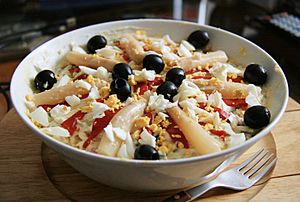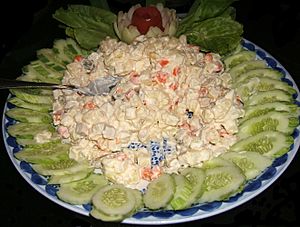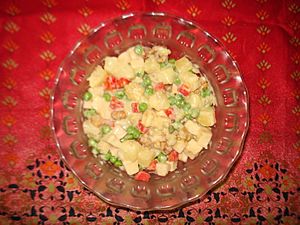Olivier salad facts for kids
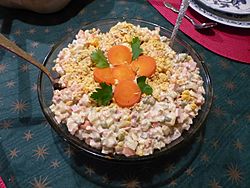 |
|
| Alternative names | Russian salad, Stolichny salad |
|---|---|
| Type | Salad |
| Course | Zakuski |
| Place of origin | Russia |
| Created by | Lucien Olivier |
| Main ingredients | Potatoes, vegetables, eggs, meat, mayonnaise |
Olivier salad (Russian: салат Оливье, tr. salat Olivye) is a very popular salad from Russian cuisine. It's also well-known in many other countries around the world.
Today, people usually make it with diced boiled potatoes, carrots, and pickles. It also has green peas, eggs, and often boiled chicken or bologna sausage. Everything is mixed with mayonnaise and seasoned with salt and pepper.
In many places, this dish is called Russian salad. In Brazil, it's known as Maionese. Some Scandinavian countries call it italienisk salat (Italian salad) because of its colors. In former Yugoslavian countries, it's called ruska salata.
In Russia and other countries that were once part of the Soviet Union, this salad is a main dish for New Year's Eve celebrations. It's often served as part of a spread of appetizers called zakuski.
Contents
The Story of Olivier Salad
The original Olivier salad was created in the 1860s. A Belgian chef named Lucien Olivier invented it. He was the head chef at the Hermitage, a very famous restaurant in Moscow, Russia.
Olivier's salad quickly became super popular with the restaurant's customers. It was known as the Hermitage's special dish.
Around the year 1900, one of Olivier's assistant chefs, Ivan Ivanov, tried to steal the secret recipe. Chef Olivier always made his special dressing alone. One evening, Olivier was called away suddenly. Ivanov quickly snuck into Olivier's kitchen. He watched how Olivier had set up his ingredients. This helped Ivanov guess what was in the famous dressing.
Ivanov then left Olivier's restaurant. He started working as a chef at a different restaurant called Moskva. There, he began serving a salad that looked very similar. He called it "metropolitan salad" (Russian: Столичный, tr. Stolichny). However, people who tasted both salads said Ivanov's dressing wasn't as good as Olivier's. They felt it was "missing something."
Later, Ivanov sold his version of the recipe to different publishers. This helped the salad become even more famous. The Hermitage restaurant closed in 1905, and the Olivier family left Russia. After that, people started calling the salad simply "Olivier."
One of the first printed recipes for Olivier salad appeared in 1894. It listed fancy ingredients like hazel grouse (a type of bird), crayfish tails, and special sauces.
Over time, as often happens with popular recipes, the rare and expensive ingredients were replaced. People started using cheaper and easier-to-find foods instead.
What's in Olivier Salad?
The very first known recipe for Olivier salad was printed in a Russian magazine in 1894. It mentioned special "mogul sauce" or "kabul sauce," which were like Worcestershire sauce.
An 1897 cookbook described a recipe with grouse (a bird), crayfish, potatoes, cucumber, lettuce, and mayonnaise. It said you could use veal or chicken, but the real recipe used grouse.
After the Russian Revolution, ingredients became harder to find. So, people started using cheaper options. For example, chicken or sausage replaced grouse. Hard-boiled eggs replaced crayfish. Pickled cucumbers and green peas replaced fresh cucumbers, olives, and capers.
In the past, the salad often included cold meats like ham or veal tongue. Some fancy versions in the mid-1900s even had lobster or truffles.
Today, the most common Olivier salad uses boiled diced vegetables mixed with mayonnaise. It often has a type of sausage called Doktorskaya. Another popular version uses boiled or smoked chicken instead of sausage. This one is often called Stolichny salad, after Ivanov's version.
Modern Olivier Salad
The Olivier salad we see today is very popular. It usually has boiled potatoes, dill pickles, peas, eggs, carrots, and boiled beef, chicken, or bologna sausage. It's all mixed with mayonnaise. This version is actually more like Ivanov's Stolichny salad. It's quite different from Olivier's original fancy creation.
This salad was a must-have for any Soviet holiday dinner, especially for New Year's Eve. It was popular because its ingredients were easy to find even in winter. Even though many different foods are available in Russia now, Olivier salad is still super popular. It's often the most traditional dish for New Year's celebrations at home.
Homemade versions in Russia and other post-Soviet countries often depend on what the cook prefers. Some ingredients are always included, but others might be added or left out.
Olivier Salad Around the World
Olivier salad is enjoyed in many countries, often with slightly different names and ingredients.
Southeast Europe
In Serbia, Bulgaria, and North Macedonia, it's called ruska salata (Russian salad). The Bulgarian version often has potatoes, carrots, peas, pickles, and some kind of salami or ham. In Bosnia and Herzegovina, both ruska salata and francuska salata (French salad, without meat) are popular for holidays.
In Croatia and Slovenia, a similar salad without meat and potatoes is called francuska salata or francoska solata, meaning French salad.
The Romanian version is called salată de boeuf ("beef salad"). It's a traditional dish with finely chopped beef (or chicken) and root vegetables. It's mixed with mayonnaise and topped with traditional Romanian pickles. You can also make a vegetarian version.
In Turkey, it's known as Rus salatası ("Russian Salad"). This version has boiled and sliced carrots and potatoes, sliced cucumber pickles, boiled peas, and mayonnaise. It's sometimes decorated with boiled eggs, black olives, and beet pickles. It's served as a meze (appetizer) or as a filling for sandwiches.
Central Europe
In Slovakia, it's called zemiakový šalát ("potato salad"). It usually has boiled and cubed vegetables like potatoes and carrots, finely chopped onions, and pickles in a mayonnaise dressing. It often includes hard-boiled eggs and canned green peas.
In the Czech Republic, it's simply called bramborový salát ("potato salad"). It's made with boiled and cubed vegetables, onions, pickles, and mayonnaise. It's a popular side dish for schnitzel or breaded carp during Christmas meals.
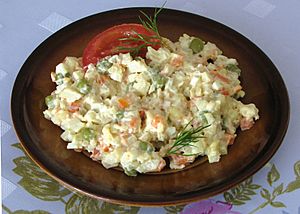
Polish sałatka jarzynowa or sałatka warzywna ("vegetable salad") is vegetarian. It has peas, hard-boiled eggs, and chopped vegetables, all mixed with mayonnaise. Recipes can vary, sometimes adding apples or pickles. A special version from Silesia called szałot might even include bacon, sausages, or pickled herring. These salads are often served at family celebrations, especially on Christmas Eve.
In Hungary, the meatless version is called "Franica saláta" (French Salad). Versions with meat are called "Orosz hússaláta" (Russian meat salad). It's a popular food all year.
Southern Europe
In Greece, it's called ρώσικη σαλάτα (rossiki salata). It usually doesn't have meat. Ensaladilla rusa ("Russian little salad") is very popular in Spain. It's often served as a tapa (small dish) in bars. It usually has minced boiled potato, carrots, canned tuna, eggs, peas, and mayonnaise. In Italy, Insalata russa has similar ingredients. A similar salad is also popular in Portugal, called salada russa. It's often served alone or with fish.
Northern Europe
In Norway, Iceland, and Denmark, it's called russisk salat. It has carrots and green peas in mayonnaise. It might also include small shrimp. This salad is often eaten with smoked meat on bread. In Finland, a regional salad uses spaghetti instead of potatoes. In the Netherlands, there's a similar salad called Huzarensalade ("Hussar Salad"). Its name might come from Dutch hussar soldiers.
Asia
Olivier salad (Persian: الويه) is popular in Iran. It's usually made with potatoes, eggs, Persian pickled cucumbers, carrots, chicken, peas, and mayonnaise. It's often used as a sandwich filling.
It's also a popular salad in Vietnam, Bangladesh, Pakistan, and India. There, it's usually made with potatoes, peas, apples or pineapples, and mayonnaise. It's often a side dish in cafes.
Japanese potato salad (potesara) is thought to be a Japanese version of Olivier salad. It has a softer, semi-mashed potato texture. It uses chopped ham as the main meat and a lot of rice vinegar and karashi mustard in its dressing.
Olivier salad is known as "Capital salad" or "Niislel salad" in Mongolia. It usually has minced ham and carrots, boiled eggs, and potatoes, all mixed with mayonnaise. It's very popular, especially during holidays.
Latin America
The dish is very popular in many Latin American countries. It's called ensalada rusa there. It's often simplified to just minced boiled potatoes and carrots, green beans, and lots of mayonnaise. In Argentina, it's often served as a first course. It can also be served with thinly sliced beef called matambre, in a dish called matambre con rusa. In Peru, Chile, Colombia, Venezuela, and Argentina, it's a traditional Christmas side dish. In Haiti, “salad russe” has diced boiled vegetables like beets, carrots, potatoes, and sometimes corn, mixed with mayonnaise and spices.
Images for kids
See also
 In Spanish: Ensalada rusa para niños
In Spanish: Ensalada rusa para niños


